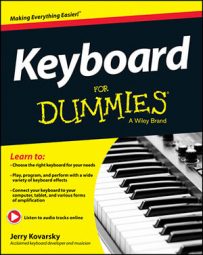Divide the beat
To get the hang of playing in between full-beat notes, you need to be able to count the beat in a divided fashion. Try this:-
Start counting a 4/4 pulse, saying “1, 2, 3, 4” over and over in time.
-
When you’re comfortable, try saying “and” between each number: “1 and 2 and 3 and 4 and . . . .”
The 1, 2, 3, 4 are still in the same place, with the and occurring quickly in between.
Listen to the Chapter 5, Track 22 to hear this divided counting exercise.

Apply the divided beat to eighth and sixteenth notes
When you divide the quarter note into two equal halves, called the eighth note. It’s filled in like the quarter note but has a curly flag design on the stem. When you have more than one eighth note in a row, you connect the stems with a beam.
The eighth note gets half of a beat, so when you’re counting music that has eighth notes you should use the and between the numbers. As you get comfortable, you can learn to play two notes per beat without counting each one.
You can further divide the eighth note in half; the resulting note is called the sixteenth note. It looks like an eighth note with a double flag or double beam attached. It divides the main pulse or beat into four equal parts. You count that this way: “1-ee-and-ah, 2-ee-and-ah, 3-ee-and-ah, 4-ee-and-ah,” and so on.

Try keeping a steady beat (clapping or tapping your foot) and practice counting a few bars of quarter notes (1, 2, 3, 4 . . .). Then move to eighth notes, which are twice as fast (1 and, 2 and, 3 and, 4 and . . .). Move next to sixteenth notes, which are twice as fast as the eighth notes (1-ee-and-ah, 2-ee-and-ah, 3-ee-and-ah, 4-ee-and-ah . . .).
Go back to the quarter notes and then try sixteenth notes again; now they’re four times as fast. Be sure your clapping/tapping of the pulse stays the same (on the numbers); only your speaking of the rhythm is changing speed.
Check out this counting exercise in Chapter 5, Track 23.
Feeling confident? Try it the other way around! Keep counting only 1, 2, 3, 4; try clapping quarter notes (one clap for each number spoken) and then move to clapping eighth notes (two even claps for each number spoken).
Don’t change your counting; don’t say “and” in between. Just clap twice for each number spoken. When you can go back and forth between clapping quarter and eighth notes, try going to sixteenth notes (four even claps per number spoken). It will be twice as fast as the eighth notes or four times as fast as your counting. Be sure to keep your counting perfectly steady at all times.
Listen to this alternating counting exercise in Chapter 5, Track 24.

